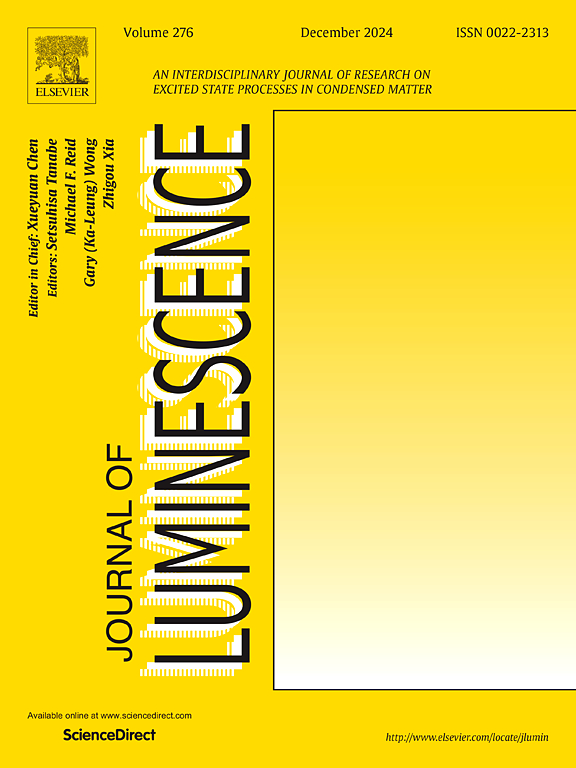Regulating broadband near-infrared luminescence and thermal stability of Cs2AgBiCl6 double perovskite via alkali metal ions doping
IF 3.3
3区 物理与天体物理
Q2 OPTICS
引用次数: 0
Abstract
Lead-free double perovskites have attracted much attention for their unique optical properties, though achieving efficient broadband near-infrared (NIR) emission with them remains a challenge. In this work, we successfully synthesized a new microcrystalline structure of lead-free double perovskites Cs2Ag1-xRxBiCl6 (R = Na, K, Rb) using a simple chemical reflux method, achieving NIR emission. Notably, Cs2Ag0.7K0.3BiCl6 demonstrates a broad emission spectrum spanning from 500 to 1200 nm with a significant half-peak width of 300 nm under 365 nm excitation. This is attributed to the doping of alkali metal ions can break the inherent parity-forbidden transition and induce strong exciton-phonon coupling through lattice distortion. Temperature-dependent photoluminescence spectroscopy and density functional theory calculations analysis reveal that alkali metal ions can enhance the thermal stability of self-trapped exciton emission by reducing exciton-phonon coupling strength. Finally, we demonstrate the promising applications of Cs2Ag0.7K0.3BiCl6 crystals with broad emission bands for NIR night vision and information encryption. This provides new insights into the realization of near-infrared emission and thermal stability regulation.
碱金属离子掺杂调控Cs2AgBiCl6双钙钛矿宽带近红外发光及热稳定性
无铅双钙钛矿因其独特的光学特性而备受关注,但利用其实现高效的宽带近红外(NIR)发射仍然是一个挑战。本文采用简单的化学回流法,成功合成了一种新型无铅双钙钛矿Cs2Ag1-xRxBiCl6 (R = Na, K, Rb)微晶结构,实现了近红外发射。值得注意的是,Cs2Ag0.7K0.3BiCl6在365 nm激发下具有500 ~ 1200 nm宽的发射光谱,其中半峰宽度为300 nm。这是由于碱金属离子的掺杂可以打破固有的宇称禁止跃迁,并通过晶格畸变诱导强激子-声子耦合。温度依赖性光致发光光谱和密度泛函理论计算分析表明,碱金属离子可以通过降低激子-声子耦合强度来增强自俘获激子发射的热稳定性。最后,我们展示了具有宽发射带的Cs2Ag0.7K0.3BiCl6晶体在近红外夜视和信息加密方面的应用前景。这为实现近红外发射和热稳定性调控提供了新的思路。
本文章由计算机程序翻译,如有差异,请以英文原文为准。
求助全文
约1分钟内获得全文
求助全文
来源期刊

Journal of Luminescence
物理-光学
CiteScore
6.70
自引率
13.90%
发文量
850
审稿时长
3.8 months
期刊介绍:
The purpose of the Journal of Luminescence is to provide a means of communication between scientists in different disciplines who share a common interest in the electronic excited states of molecular, ionic and covalent systems, whether crystalline, amorphous, or liquid.
We invite original papers and reviews on such subjects as: exciton and polariton dynamics, dynamics of localized excited states, energy and charge transport in ordered and disordered systems, radiative and non-radiative recombination, relaxation processes, vibronic interactions in electronic excited states, photochemistry in condensed systems, excited state resonance, double resonance, spin dynamics, selective excitation spectroscopy, hole burning, coherent processes in excited states, (e.g. coherent optical transients, photon echoes, transient gratings), multiphoton processes, optical bistability, photochromism, and new techniques for the study of excited states. This list is not intended to be exhaustive. Papers in the traditional areas of optical spectroscopy (absorption, MCD, luminescence, Raman scattering) are welcome. Papers on applications (phosphors, scintillators, electro- and cathodo-luminescence, radiography, bioimaging, solar energy, energy conversion, etc.) are also welcome if they present results of scientific, rather than only technological interest. However, papers containing purely theoretical results, not related to phenomena in the excited states, as well as papers using luminescence spectroscopy to perform routine analytical chemistry or biochemistry procedures, are outside the scope of the journal. Some exceptions will be possible at the discretion of the editors.
 求助内容:
求助内容: 应助结果提醒方式:
应助结果提醒方式:


